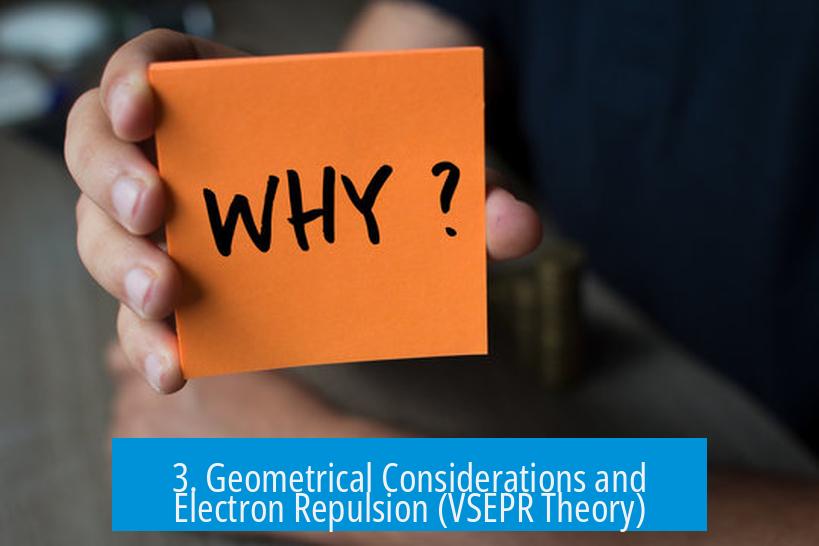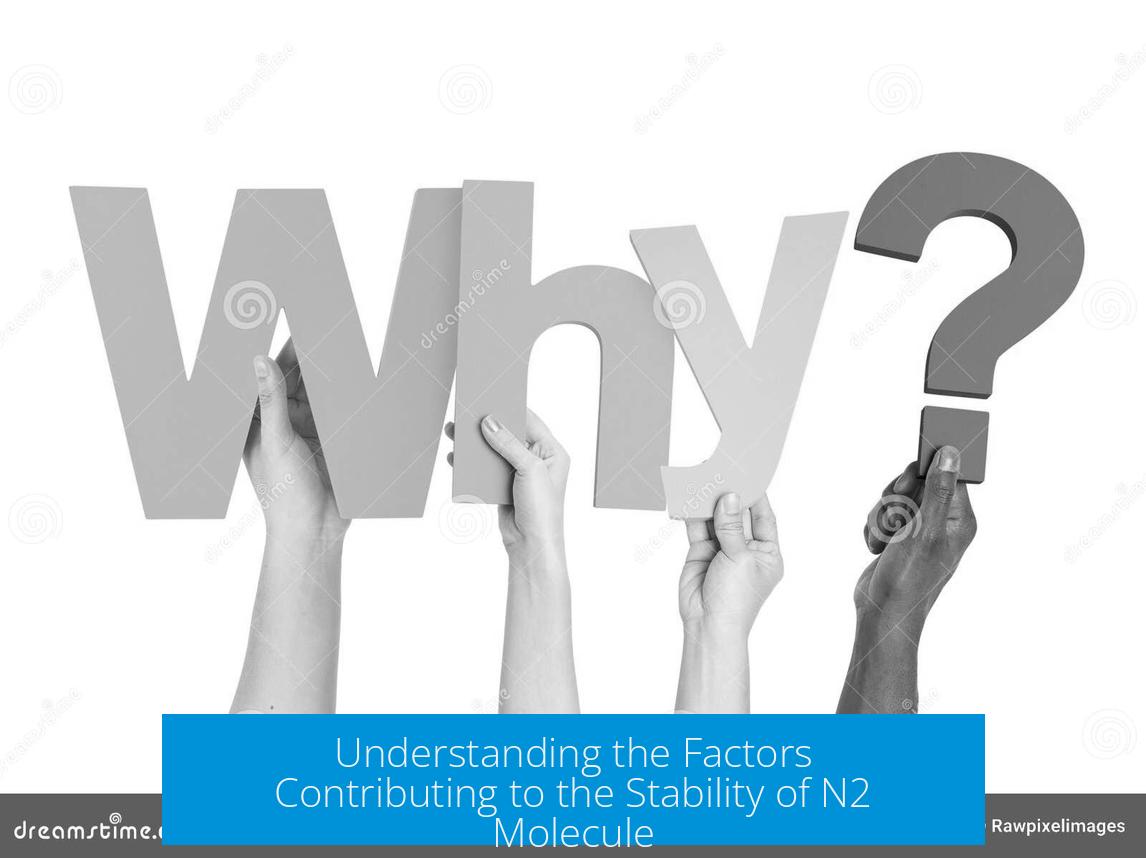Why is N2 Stable?

Nitrogen gas (N2) is stable because it has a very strong triple bond formed by fully occupied bonding molecular orbitals, characterized by a high bond dissociation energy that makes breaking the bond difficult under normal conditions.
1. Molecular Orbital Configuration
The stability of N2 stems from its electronic structure described by molecular orbital (MO) theory. In the N2 molecule, atomic orbitals combine to form molecular orbitals. All the bonding molecular orbitals—those that promote bond formation—are fully occupied by paired electrons. This complete filling of bonding orbitals ensures strong electron sharing between the two nitrogen atoms.
The key point is the triple bond, composed of one sigma (σ) and two pi (π) bonds. This triple bond has an exceptionally high bond dissociation energy, around 945 kJ/mol. The high energy required to break this bond reflects the strength and stability of N2. The molecular orbital framework explains why the bond is less reactive, as antibonding orbitals remain unoccupied.
2. Electron Configuration and Bond Pairing
Each nitrogen atom has the electron configuration 1s2 2s2 2p3, with three unpaired electrons in the 2p orbitals. When two nitrogen atoms approach, these unpaired electrons pair up perfectly, forming three covalent bonds.
The presence of these three bonding pairs simultaneously between the atoms results in a strong triple bond. The perfect pairing creates a stable electron structure that lowers the overall energy of the molecule. This electron configuration explains why N2 has fewer reactive sites compared to atoms with single or double bonds.
3. Geometrical Considerations and Electron Repulsion (VSEPR Theory)

Valence Shell Electron Pair Repulsion (VSEPR) theory helps understand the spatial arrangement of electrons in N2. The nitrogen atoms each have a lone pair of electrons in addition to the bonding pairs.
This lone pair exerts repulsive forces that push bonding electrons closer together, effectively strengthening the triple bond. Compared to molecules like carbon-carbon triple bonds in acetylene (C2H2), the lone pairs in nitrogen exert additional electronic pressure, enhancing bond stability.
4. Thermodynamic Stability and Reactivity
N2 shows thermodynamic stability as breaking its triple bond requires input energy, unlike some molecules where bond breaking releases energy. For example, combustion of ethyne (C2H2) releases energy, while the reaction of N2 with oxygen to form nitrogen oxides is endothermic and harder to initiate.
This energy barrier contributes to the inertness of atmospheric nitrogen under normal conditions. High temperatures or catalysts are necessary to overcome this barrier, which demonstrates its inherent stability from a thermodynamic perspective.
5. Comparison with Other Nitrogen Species and Molecules
Nitrogen gas is more stable than other nitrogen compounds such as nitrogen oxides (NO, NO2) or hydrazine (N2H4). These other molecules contain nitrogen-nitrogen bonds of lower order or additional reactive sites, making them more reactive and less stable.
The greater stability of N2 explains its abundance in the atmosphere and reluctance to undergo spontaneous reactions, contrasting with unstable reactive nitrogen species.
6. Industrial Significance: Breaking the N≡N Bond
Though highly stable, the nitrogen triple bond can be broken under controlled conditions. The Haber-Bosch process accomplishes this by applying high temperature, high pressure, and metal catalysts to convert N2 and H2 into ammonia (NH3).
This process demonstrates the difficulty of cleaving the strong N≡N bond. It also illustrates chemists’ ability to overcome the considerable energy barrier to reactive nitrogen compounds through industrial methods.
7. Orbital Symmetry and Comparison with Carbon Molecules
Carbon molecules such as C2 do not form similarly stable triple bonds because of differences in orbital symmetry and electron occupancy. Carbon has degenerate orbitals that are only half occupied, leading to different bonding preferences than nitrogen.
In nitrogen, the symmetry and full occupancy allow strong σ and π bonds, resulting in a bond order of three. This difference in orbital configuration explains why nitrogen’s triple bond is stronger and more stable than analogous carbon-carbon bonds.
8. Energy Barrier for Bond Cleavage
Breaking the triple bond in N2 involves overcoming a significant kinetic energy barrier. This barrier arises from the large bond dissociation energy and the absence of antibonding electrons in the ground state.
The high activation energy renders N2 inert under normal conditions, limiting its chemical reactivity and increasing its longevity in the atmosphere.
Key Takeaways
- N2 stability results from the complete filling of bonding molecular orbitals leading to a strong triple bond.
- The electron configuration of nitrogen atoms enables perfect pairing of unpaired electrons forming the triple bond.
- Lone pairs on nitrogen atoms increase the bond strength via electron repulsion effects explained by VSEPR theory.
- High bond dissociation energy and thermodynamic properties make N2 chemically inert and stable.
- N2 is more stable than many other nitrogen-containing species, influencing its prevalence in nature.
- Industrial processes like Haber-Bosch demonstrate the energy input required to break the N≡N bond.
- Orbital symmetry differences compared to carbon explain why similar molecules lack the triple bond’s strength.
- The large energy barrier to bond cleavage protects N2 from easy reaction or dissociation.
Why does N₂ have such a strong triple bond?
N₂ has a triple bond because all bonding molecular orbitals are fully occupied. This arrangement leads to a high bond energy. It makes the triple bond very hard to break and keeps N₂ stable.
How does electron configuration affect N₂ stability?
Each nitrogen atom has unpaired electrons in its p orbitals. When two atoms bond, these electrons pair perfectly. This perfect pairing creates a strong, stable triple bond between them.
What role does the lone pair on nitrogen play in its stability?
The lone pair on each nitrogen atom repels bonding electrons. This repulsion pushes the bonds closer, increasing bond strength. It is a key difference compared to molecules without lone pairs, like carbon compounds.
Why is N₂ harder to react with oxygen than ethyne?
N₂ combustion is endothermic, meaning it needs energy to break the triple bond. Ethyne combustion releases energy because its bonds are easier to break. This energy difference shows why N₂ is more stable thermodynamically.
How does molecular orbital theory explain N₂’s stability?
Molecular orbital theory shows that the nitrogen molecule has fully filled bonding orbitals and empty antibonding ones. This full occupancy results in a strong net bonding effect, making N₂ very stable and inert.
Why is it difficult to break the N≡N bond despite N₂’s stability?
Breaking the triple bond requires surpassing a large energy barrier. This high bond dissociation energy means N₂ rarely reacts under normal conditions and demands special processes, like Haber-Bosch, to split the bond.





Leave a Comment